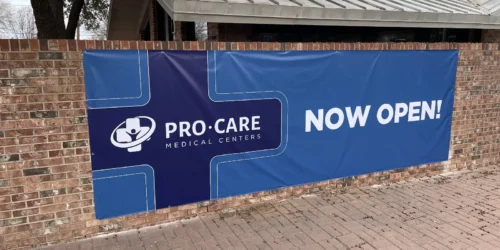One of the most common reasons that people visit the doctor each year is back pain. From car accident injuries to chronic pain, back discomfort can happen at any age for various reasons. But what do you do when you start noticing other symptoms occurring at the same time as back pain? If you notice nausea or feelings of sickness at the same time as back pain, you could be dealing with a number of different health conditions. Let’s discuss some of the most common explanations for why you might be experiencing back pain and nausea at the same time and what you can do about it.
Can Back Pain Cause Nausea?
Yes, these two different sensations can be related and linked. Your brain sends and receives signals through the nervous system that connects with various parts of the body (including your gut). Specialized nerve cells known as nociceptors found in the skin, muscles, and other body tissues send information about pain to the brain. Injury, inflammation, and other harmful stimuli can all stimulate nociceptors that then send messages to the brain. Once your brain receives these messages, it creates a conscious perception of pain.
But sometimes messages can overlap and affect more than just pain perception. For example, pain from spinal injuries can activate the autonomic nervous system, which in turn can trigger nausea. Inflammation or muscle spasms in the back can also irritate nearby nerves, including those that influence the digestive system, leading to nausea. In other scenarios, traumatic events that cause back pain can also cause stress that leads to stomach discomfort.
Conditions That May Cause Back Pain & Nausea
Let’s discuss some common conditions and injuries that might cause back pain and nausea at the same time:
Digestive Tract-Related Back Pain and Nausea
This type of back pain and nausea can occur with gastrointestinal issues such as irritable bowel syndrome, inflammatory bowel disease, or ulcerative colitis. Inflammation, indigestion, and other issues within the digestive system can cause abdominal pain that may radiate into the back. Nausea may also accompany these symptoms as the body tries to expel the irritants.
Cervicogenic Headaches
A cervicogenic headache is a specific type of headache that commonly starts in the neck or top of the spine. They can result in a reduced range of motion in the neck because movement often exacerbates symptoms and discomfort. These types of headaches can cause pain in the neck that radiates into the upper back, along with other symptoms like nausea and vomiting. Dizziness and difficulty balancing are commonly associated with cervicogenic headaches and can also amplify the feelings of nausea.
Liver Disease
There are many health conditions that can damage the liver and prevent it from functioning properly, including alcoholic hepatitis, cirrhosis of the liver, and hepatitis. Along with the common symptoms of nausea and vomiting, many people report general pain in the abdomen and back due to the liver’s location. When inflamed and enlarged, it can exert pressure on surrounding organs and tissue, further causing pain around the back and sides.
Pancreatitis
Pancreatitis is an inflammation of the pancreas, an organ located in the lower part of the abdomen (and therefore has similar reasons for back pain and nausea as liver disease). It can put pressure on your spine, leading to radiating pain that feels like it’s penetrating the back. This condition may start suddenly and last for a short period of time, or develop gradually over many years. Common symptoms of pancreatitis include abdominal pain, nausea, and vomiting.
Kidney Stones
Kidney stones are hard deposits of minerals and acid salts that develop in the kidneys and can cause significant pain when passed. While kidney stones usually don’t cause permanent damage, they often result in severe pain and sharp discomfort while passing through the urinary tract. Kidney stones typically cause pain in the side of the abdomen, and the intense pain may also trigger lightheadedness, intense stress response, and nausea.
Ulcers
A stomach ulcer, also known as a peptic ulcer, is a type of sore that develops on the lining of the stomach. An ulcer can develop if stomach acid damages the protective barrier of the digestive tract. This can cause upper abdominal pain that often feels like burning, along with symptoms like radiating pain in the back, nausea, and vomiting.
Appendicitis
If the appendix becomes inflamed and filled with pus, it can cause severe pain in the lower abdomen and back along the right side of the body. As with several above conditions, this can cause an inflammatory and stress response that results in nausea, vomiting, fever, and chills. Appendicitis is usually treated with surgery and antibiotics.
Endometriosis
Endometriosis is a health condition where the tissue that normally lines the uterus grows outside of the uterus. This tissue can be found on the ovaries, fallopian tubes, intestines, and other abdominal areas. The result is often inflammation and pain, typically in the lower abdomen and pelvis. Common symptoms of endometriosis are pain and irregularities with menstruation.
Pregnancy-Related Back Pain & Nausea
Women go through a lot of obvious physical changes to their bodies when pregnant. Changes to hormone levels (particularly human chorionic gonadotropin and estrogen) can trigger nausea and vomiting, while back pain can occur as the baby grows and places more strain on back muscles and the spine. Stress from one factor may also exacerbate other symptoms, causing a feedback loop. This is why it’s always best to let your doctor know when you experience abdominal pain, nausea, and other symptoms.
Can Car Accidents Cause Back Pain & Nausea?
Another situation that may lead to back pain and nausea is a car accident:
- The sudden jerking motion in a crash can cause back pain, and the body’s pain response may trigger nausea.
- Concussions can cause dizziness, headaches, and nausea, which often accompany back pain if the spine is also affected.
- Herniated discs or spinal misalignment from the accident can compress nerves and cause severe back pain (and nausea as a result of altered nerve signals).
- The adrenaline surge, stress reaction, and traumatic response after an accident can worsen pain and trigger nausea.
When to See a Doctor for Back Pain and Nausea
Again, it’s crucial for anyone experiencing back pain and nausea to seek medical evaluation promptly. Proper diagnosis and treatment are essential to address both the pain and the underlying causes of discomfort, ensuring a full and safe recovery. If you have one of the health conditions mentioned above and notice a change in your symptoms, see a back pain doctor.
For example, an increase in back pain or the addition of other symptoms may signal that further treatment is necessary. In some cases, the relationship between your back pain and nausea symptoms may not be clear, and further evaluation may be necessary. Your doctor may want to run tests like bloodwork or diagnostic imaging for a better understanding of what is causing your symptoms and help you get lasting relief.
Get Expert Care from Specialists
Don’t let chronic pain keep you from living your best life. Visit a Pro-Care location near you to speak with one of our back pain specialists, neurologists, or pain management doctors for quality, comprehensive care. Learn more about our team or book your appointment today!



